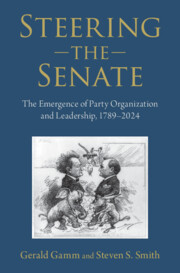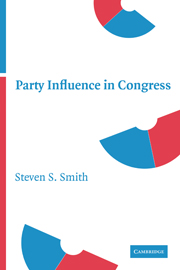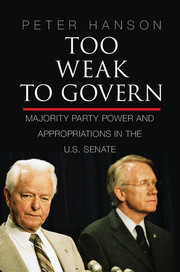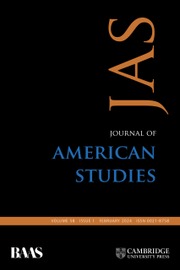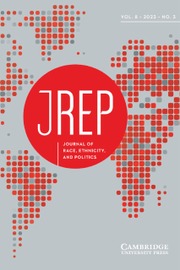Steering the Senate
The Senate majority and minority leaders stand at the pinnacle of American national government – as important to Congress as the speaker of the House. However, the invention of Senate floor leadership has, until now, been entirely unknown. Providing a sweeping account of the emergence of party organization and leadership in the US Senate, Steering the Senate is the first-ever study to examine the development of the Senate's main governing institutions. It argues that three forces – party competition, intraparty factionalism, and entrepreneurship – have driven innovation in the Senate. The book details how the position of floor leader was invented in 1890 and then strengthened through the twentieth and twenty-first centuries. Drawing on the full history of the Senate, this book immediately becomes the authoritative source for understanding the institutional development of the Senate – uncovering the origins of the Senate party caucuses, steering committees, and floor leadership.
- Explains how and why party leadership emerged in the US Senate, including the invention of party caucuses, steering committees, and floor leaders
- Provides a sweeping account of the rise of the modern Senate that focuses on the development of the institutions that govern the modern Senate, the party caucus (or conference) and the positions of majority leader and minority leader
- Offers a comprehensive framework for analyzing and understanding emergence of party leadership
Reviews & endorsements
‘Put most directly, Gerald Gamm and Steve Smith have produced a tour de force book in Steering the Senate. Their research diligence, skilled analysis, theoretical grasp, and engaging presentation have yielded bountiful returns on their investment of several decades. They have uncovered new material and findings about the Senate, its parties and leadership, and their development. In doing so Gamm and Smith not only rewrite the history of the Senate, correcting much of the existing conventional wisdom and myths, but they also offer a persuasive theory for understanding when parties and leadership make major institutional changes. Not only is Steering the Senate a must read for political scientists and historians who study American political institutions and for their students, but it will also be valuable for journalists, staff, lobbyists, officeholders who frequent the Senate corridors.’ Bruce Oppenheimer, Professor Emeritus of Political Science, Vanderbilt University
‘Gerald Gamm and Steve Smith have produced a stunning and thought-provoking history of leadership in the Senate. Taking a deep dive into the evolution of an institution where the job of being up top is like herding cats, these leading political scientists show us, through painstaking historical research, how changes in the organization of the upper chamber allowed for a more centralized and forceful style of partisan decision-making to take place. A landmark piece of scholarship.’ Julian Zelizer, Princeton University
‘A must read for students of Congress, Steering the Senate offers the definitive account of the development of the modern Senate. Drawing upon a careful analysis of more than two hundred years of history, Gamm and Smith demonstrate the critical role of party competition and factional maneuvering in generating innovations in party leadership that gave rise to today’s highly centralized Senate.’ Eric Schickler, University of California, Berkeley
‘Professors Gamm and Smith have produced one of the most important volumes ever written about the United States Senate. Groundbreaking in its research, extraordinary in its scope and erudition, and keen in its insights, Steering the Senate is a magisterial work about the development of Senate leadership and is an essential read for anyone who wants to know how the upper chamber has operated and innovated throughout its history.’ Roy E. Brownell, II, Co-author, The U.S. Senate and the Commonwealth
‘Gerald Gamm and Steve Smith have written a masterpiece of Senate history, unearthing new information on the emergence of leadership institutions and the role of parties and showing their relevance for the Senate of today.. Using newspapers as well as memoirs and the full body of research on the Senate, they trace the evolution of the Senate from its earliest days, providing insights that previous generations of scholars missed. Steering the Senate will become a new standard for scholarship on Congress.’ Norman Ornstein, emeritus scholar, The American Enterprise Institute
‘Gamm and Smith make a landmark contribution to our understanding of congressional development. They provide the first comprehensive account of the development of Senate party leadership across United States history. Pieced together from painstaking research in newspapers and other primary sources, they tell a fascinating story of institutional innovation under pressures of party competition. Over time, leaders have progressively cumulated more resources and responsibilities, culminating today in the strongest party leaders in Senate history.’ Frances E. Lee, Professor of Politics and Public Affairs, Princeton University
‘Steering the Senate is a tour de force-a strikingly original and ambitious account of the partisan evolution of the U.S. Senate. Gamm and Smith delve deep into decades of unmined historical archives to establish the origins, development, and limits of today’s highly centralized and partisan leadership of the Senate. Essential reading for all who care-or worry-about the past and future of institutional leadership and capacity on Capitol Hill.’ Sarah Binder, George Washington University and The Brookings Institution
‘Steering the Senate is a landmark contribution to scholarship about the chamber and to congressional leadership more generally. Combining meticulous research in primary source documents and the standard tools of quantitative social science, Gamm and Smith have produced an innovative volume that should be read by any serious student of American political institutions and history. It is by far the best book we have about the organizational development of the Senate.’ C. Lawrence Evans, William & Mary
Product details
July 2025Hardback
9780521883528
496 pages
229 × 152 mm
0.821kg
Available
Table of Contents
- 1. Individual goals and senate party organization
- 2. Presiding officer, 1789–1914
- 3. Caucus, 1789–1879
- 4. Steering Committee, 1856–1913
- 5. Arthur Pue Gorman, the Federal Elections Bill, and the invention of Elected Floor Leadership, 1890–1913
- 6. Leaders and whips, 1913–1924
- 7. Divergent paths and the consolidation of leadership structures, 1923–1944
- 8. Party infrastructure, 1945–1980
- 9. Polarization, competition, and centralization, 1981–2024
- 10. Conclusion
- Appendix.

